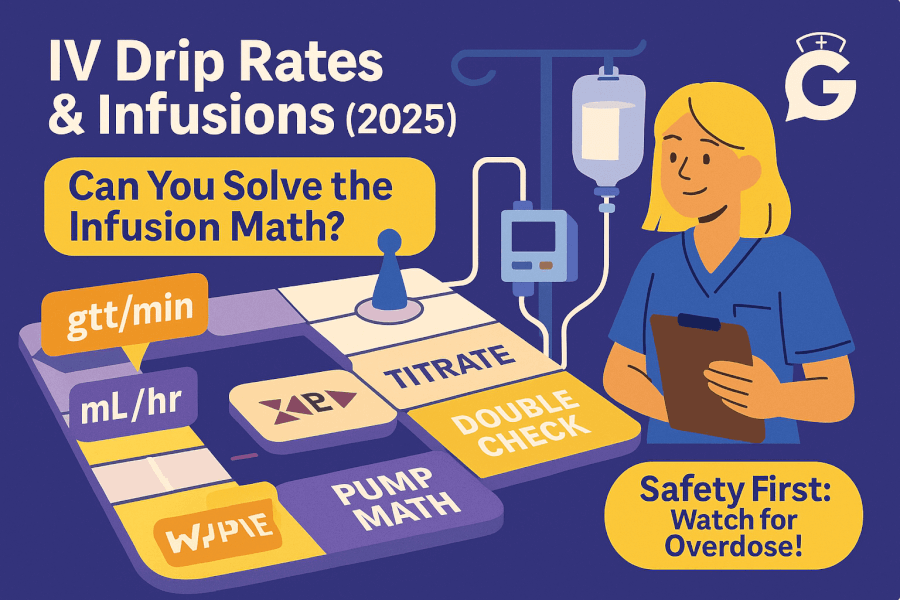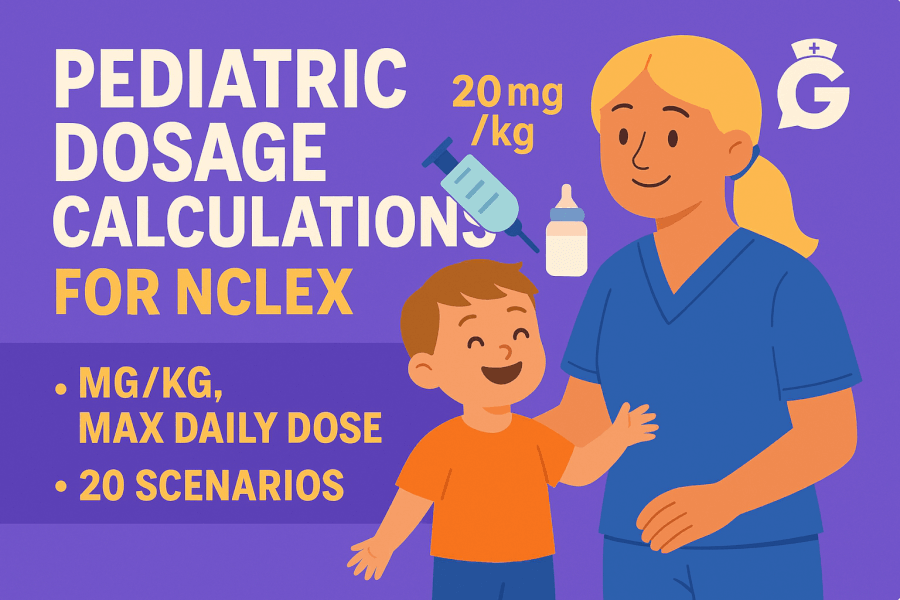If you can set up unit-canceling fractions and follow a few safety checks, you can run any infusion confidently—from gravity drips (gtt/min) to smart-pump mL/hr and mcg/kg/min titrations. This guide gives you a repeatable method, real-world troubleshooting, and practice so you’re safe on the floor and sharp for NGN.
For clinical-judgment practice, pair this with NGN Med-Surg / Physiological Adaptation Case Studies (2025). If you want AI to scaffold your math step-by-step, see AI in Nursing Education (2025): Complete Guide and the AI Prompt Library for Nursing Students (2025).
🎯 Free NCLEX quiz!
Test your knowledge - new quizzes added weekly!
Table of Contents
- The Floor-Proof Method: Dimensional Analysis for IV Rates
- Gravity Drips: gtt/min with Macro- and Microdrip Sets
- Pumps: mL/hr for Primary, Secondary (IVPB) & Syringe Pumps
- Titrations: mcg/kg/min (Vasoactives) to mL/hr Formula
- Setup & Safety: Drop Factor, KVO, Infiltration/Extravasation, Vesicants
- Troubleshooting: Air, Alarms, Roller Clamp, Secondary Height, Back-Priming
- NGN Mini-Cases (with Answers)
- FAQs: Rounding, Policy, Double-Checks
- Key Takeaways
- Further Reading
🥇Voted #1 Nursing Study Tool.
Personalized AI Tutor + Instant Answers to All Your Questions. 100% Money Back Guarantee!
The Floor-Proof Method: Dimensional Analysis for IV Rates
- Write the order and the supply/concentration.
- Build a fraction chain so unwanted units cancel and the target unit remains (gtt/min, mL/hr).
- Multiply across, divide, then apply rounding rules (whole gtt, pump mL/hr per policy).
- Do a sanity check (clinical sense for this med/route/age/weight).
Professor’s note: When the stem is noisy, bold the target unit in your head—**“I need gtt/min”** or **“I need mL/hr”**—then cancel ruthlessly until only that remains.
Gravity Drips: gtt/min with Macro- and Microdrip Sets
- Macrodrip (10, 15, 20 gtt/mL) vs Microdrip (60 gtt/mL).
- Formula: gtt/min = (\frac{\textbf{mL} \times \textbf{drop factor (gtt/mL)}}{\textbf{minutes}}) → round to whole drops.
- Example: 1,000 mL over 8 hr with 15 gtt/mL → (\frac{1000 \times 15}{480} = 31.25 \Rightarrow \mathbf{31\ gtt/min}).
Clinical tips
- Set a metronome in your head (or watch): count gtt/min for reality check.
- Recount after roller-clamp bumps, arm position changes, or client transfers.
Cross-link for fluid & perfusion assessment: Renal Function & UA (2025) and Lactate in Sepsis (2025).
Pumps: mL/hr for Primary, Secondary (IVPB) & Syringe Pumps
- Formula: mL/hr = (\frac{\textbf{mL}}{\textbf{hours}}) (or (\frac{\text{mL}}{\text{minutes}} \times 60)).
- Primary vs Secondary (IVPB): hang the secondary higher; ensure back-check valve and clamp logic are correct.
- Syringe pumps: precise low-volume meds (pediatrics, vasoactives, sedatives). Program dose/weight if enabled.
Examples
- 100 mL over 30 min → 200 mL/hr.
- 250 mL over 2.5 hr → 100 mL/hr.
- 400 mL over 3 hr → 133 mL/hr (pump whole number).
For rhythm issues related to electrolyte shifts during infusions, review EKG Basics (2025) and Electrolytes (2025).
Titrations: mcg/kg/min (Vasoactives) to mL/hr Formula
Convert the bag to mcg/mL first, then:
[ \textbf{mL/hr}=\frac{\textbf{ordered mcg/kg/min} \times \textbf{kg} \times \textbf{60}}{\textbf{solution mcg/mL}} ]
Examples
- Norepinephrine 0.05 mcg/kg/min for 70 kg. Bag 4 mg/250 mL = 16 mcg/mL →
(\frac{0.05 \times 70 \times 60}{16} = 13.125 \Rightarrow \mathbf{13\ mL/hr}) per policy. - Dobutamine 5 mcg/kg/min for 80 kg. Bag 400 mg/250 mL = 1600 mcg/mL →
(\frac{5 \times 80 \times 60}{1600}= \mathbf{15\ mL/hr}).
Medication-level monitoring pearls: Therapeutic Drug Levels (2025): Vancomycin, Digoxin, Lithium.
Setup & Safety: Drop Factor, KVO, Infiltration/Extravasation, Vesicants
- Know your drop factor (package label) and tubing type (primary, secondary, blood, microdrip).
- KVO/TPA lines follow strict policy—verify compatibility and lumen use.
- Infiltration (cool, swollen, painful) vs Extravasation (vesicant injury risk): stop infusion, elevate, follow antidote protocol if ordered.
- Patency checks: flush, aspirate when policy allows, watch for resistance.
- Air management: prime tubing fully; watch for air-in-line alarms; purge per policy.
Professor’s note: Rate math won’t save a bad setup. A mis-hung secondary or closed roller clamp explains half of “wrong rate” calls in new-grad months.
Troubleshooting: Air, Alarms, Roller Clamp, Secondary Height, Back-Priming
- Air-in-line alarm: pause, clamp, purge via pump per policy; re-prime affected segment.
- No secondary infusion: lower the primary bag or clamp primary, raise the secondary; confirm back-check valve.
- Roller clamp drift (gravity): retime gtt/min after any movement.
- Back-priming secondaries: protects medication ports; verify compatibility and policy.
- Pressure alarms: check kinks, infiltration, site; try a lower limb position or warm pack per policy.
NGN Mini-Cases (with Answers)
Case 1 — Macrodrip math under pressure
- Stem: 1,000 mL LR over 8 hr using 15 gtt/mL.
- Best answer: 31 gtt/min.
- Rationale: (\frac{1000 \times 15}{480}=31.25 \Rightarrow 31). Recount after movement.
Case 2 — Secondary not dripping
- Stem: Vancomycin IVPB hanging above primary, but primary keeps running.
- Best answer: Raise secondary, ensure primary clamp above Y-site is closed, confirm back-check valve.
- Parameters: mL infused, symptom relief, site status.
Case 3 — Norepinephrine titration
- Stem: 70-kg client, order 0.05 mcg/kg/min, bag 4 mg/250 mL (16 mcg/mL).
- Best answer: 13 mL/hr per policy rounding.
- Parameters: MAP ≥ goal, UOP, mentation, distal perfusion.
Case 4 — Suspected extravasation
- Stem: Doxorubicin peripheral IV; site painful, swollen, blanching.
- Best answer: Stop infusion, elevate, follow facility vesicant protocol/antidote; notify team.
- Parameters: site status, pain, circumference.
Case 5 — Syringe pump pediatrics
- Stem: Dopamine in mcg/kg/min on syringe pump for 12-kg child.
- Best answer: Convert bag to mcg/mL, use mcg/kg/min → mL/hr formula; double-check weight & dose range.
- Parameters: MAP/HR, rhythm, UOP, mentation.
FAQs: Rounding, Policy, Double-Checks
How do I round for gtt/min?
To the nearest whole drop—there are no half drops.
Do pumps accept decimals?
Most floor pumps take whole mL/hr; some accept 0.1 mL/hr (syringe pumps). Follow policy.
Which meds require a second RN?
Commonly insulin, heparin, chemotherapy, vasoactives—check your high-alert list.
What if the math is right but vitals look wrong?
Reassess setup/site, then the client. Treat oxygenation/perfusion first; confirm with ABG or lactate when ordered (see links).
Key Takeaways
- Use dimensional analysis to land cleanly on gtt/min, mL/hr, or mL/hr from mcg/kg/min.
- Know your drop factor and tubing; microdrip = 60 gtt/mL simplifies pediatrics and drips.
- Fix the setup (height, clamps, back-check valve) before blaming math.
- Treat infiltration/extravasation fast—vesicants can injure tissue.
- Prove safety with parameters: MAP, UOP, SpO₂, RR/WOB, rhythm—then adjust.







